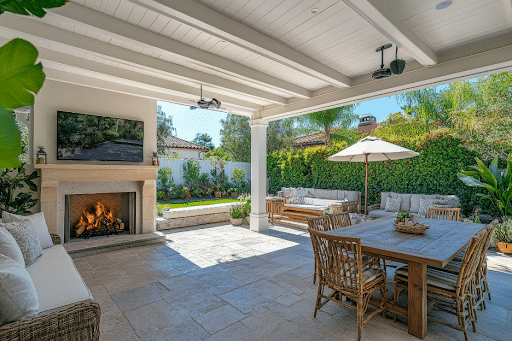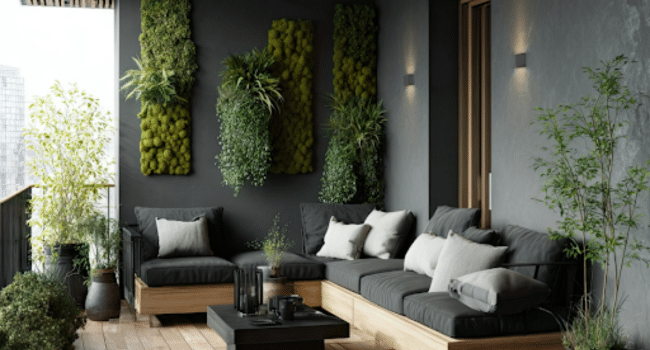Table of Contents
A flat patio is one of the most versatile and stylish ways to extend your living space outdoors. Whether you dream of a cozy corner for morning coffee, a sun-drenched area for weekend barbecues, or a sleek entertaining zone, the right patio design can transform your home’s exterior. But with so many options for materials, layouts, and styles, how do you choose the perfect flat patio design for your home?
Here’s a complete guide to help you make the right choice.
Consider Your Lifestyle and How You’ll Use the Space
Before diving into design details, it’s crucial to think about how you plan to use your patio. Your lifestyle will guide everything from the size and layout to the furniture and features you incorporate.
- For entertainment: If you love hosting gatherings, aim for a spacious design with multiple seating zones, a dining table, and an outdoor kitchen or built-in barbecue. Consider open space for dancing or games and flexible furniture arrangements to accommodate larger groups.
- For relaxation: If your patio is your personal sanctuary, focus on comfort and privacy. Add loungers, a hammock, or a miniature water feature for a soothing vibe. Incorporate elements like potted plants, soft lighting, and cozy textiles to create a retreat-like atmosphere.
- For family use: Families with children or pets benefit from durable, low-maintenance surfaces like concrete or pavers. To make it comfortable for all ages, include open areas for play, child-safe furniture, and shade features.
If you’re unsure where to start, read the One Stop Patio Shop tips or other trusted outdoor living resources for inspiration and guidance. These insights can help you refine your ideas, explore different styles, and discover which patio designs best suit your lifestyle and home layout.
Match the Patio Style to Your Home’s Architecture
Your patio should complement your home’s architectural style rather than clash with it. Think of it as an extension of the interior design, seamlessly transitioning from indoor to outdoor spaces.
- Modern homes: Clean lines, geometric shapes, and neutral color palettes work well. Materials like polished concrete, sleek tiles, or composite decking keep the aesthetic cohesive. Consider minimalist furniture with metallic or wooden accents for a sophisticated vibe.
- Traditional homes: Classic brick, stone, or terracotta tiles add warmth and timeless appeal. Layer in comfortable seating, decorative lanterns, and natural textures to create a welcoming feel that matches the home’s character.
- Coastal or contemporary homes: Light, airy pavers, glass balustrades, and open layouts emphasize space and natural light. Incorporate soft blues, whites, and neutrals, along with modern elements to complement the coastal or contemporary style.
Keeping your patio’s style consistent with your home ensures a polished, intentional look.
Choose the Right Material
Material choice affects not only the appearance of your patio but also its durability, maintenance, and long-term usability. The right material balances aesthetics with practicality.
Popular options include:
- Concrete: Highly versatile and cost-effective. You can customize it with stamping, staining, or exposed aggregate finishes to mimic stone or tile. Concrete is durable and easy to maintain.
- Pavers: Perfect for creating intricate patterns and designs. Pavers are easy to replace individually if damaged, making them a practical choice for high-traffic areas.
- Natural stone: Offers a luxurious, timeless look. Stones like slate, limestone, or travertine provide texture and elegance but can be pricier and may require sealing.
- Timber decking: This is ideal for patios that extend naturally from indoor spaces. Though it requires maintenance to protect against weathering, the aesthetic payoff is worth it.
Quick tip: Always consider your location’s weather conditions. Some materials handle heat, rain, or frost better than others. For example, concrete can crack in freeze-thaw cycles, while natural stone remains more stable. It’s a significant investment, so choosing materials suited to your climate will help keep your patio strong, safe, and long-lasting.
Think About Orientation and Shade
The position of your patio affects sunlight, temperature, and overall comfort. Before finalizing your design, consider how the orientation of your flat roof patio will interact with the natural elements throughout the day.
- Sun exposure: A north-facing patio (in the Southern Hemisphere) or south-facing patio (in the Northern Hemisphere) will receive the most sunlight, which is ideal for sunbathing or winter use. East-facing areas get morning sun, while west-facing patios are perfect for evening relaxation.
- Shade solutions: If your patio faces the afternoon sun, incorporate shade options like pergolas, retractable awnings, or large umbrellas. Shade sails are modern and flexible solutions, while trellises with climbing plants add natural coverage.
- Wind protection: Open patios can be exposed to wind. Use strategically placed walls, screens, or hedges to create a comfortable microclimate.
Proper orientation and shading increase usability and make your patio enjoyable throughout the year.
Blend Functionality With Aesthetics
A stunning patio must be practical and enjoyable to use. Balancing functionality and aesthetics ensures your space is both beautiful and livable.
- Lighting: Use a combination of ambient lighting for general visibility, task lighting for cooking or reading, and accent lighting to highlight plants or architectural features. Solar lights are eco-friendly and easy to install.
- Furniture: Select outdoor furniture that balances style, comfort, and durability. Weather-resistant materials like teak, aluminum, or synthetic wicker are ideal.
- Fire pit or fireplace: Every outdoor space benefits from a warm and inviting focal point, and a fire pit or fireplace is one of the best ways to achieve that. It creates an instant gathering spot where family and friends can relax, share stories, and enjoy the glow of an open flame.

- Landscape design: Integrate your patio with your garden or backyard for a cohesive look. Add greenery, flower beds, or vertical gardens to soften hard surfaces and create a natural, inviting space.
You may also build a bistro set for casual dining or morning coffee. Add trellis walls or decorative screens to introduce privacy and greenery. These simple touches help ensure your patio remains beautiful, functional, and enjoyable for years.
Get Professional Advice
While DIY patios can be rewarding, professional designers and builders bring expertise that saves time, money, and potential headaches. Professionals can:
- Maximize space and design flow
- Select the right materials for your climate and lifestyle
- Ensure proper drainage, foundation, and safety standards
- Help you navigate local building regulations and permits
Consulting a professional for a single planning session can help refine your ideas and prevent costly mistakes.
Final Thoughts
Choosing the perfect flat patio design is about balancing your lifestyle, aesthetic preferences, and practical needs. This space becomes an extension of your home, a place to relax, entertain, and create lasting memories.
So, take time to plan carefully before breaking ground. Seek help from professional builders to ensure the job is done right and the design complements your home. When your outdoor living area reflects how you live, it will enhance both your home and your everyday life.
